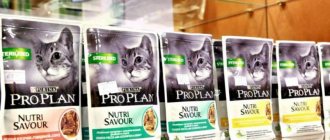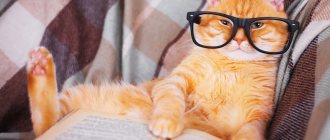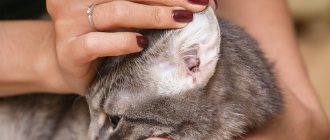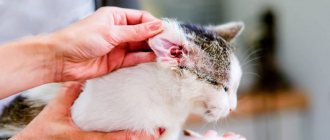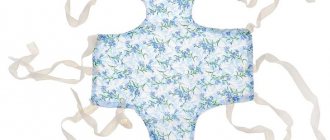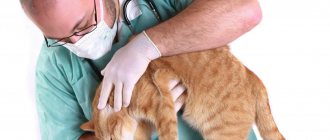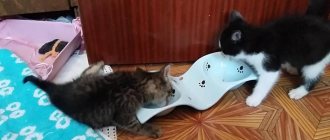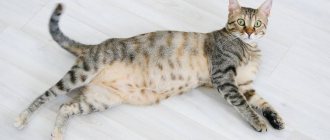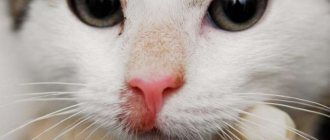Causes of dermatitis Symptoms Diagnosis Treatment Doctor's recommendations Malassezia pachydermatis
is a fungus in cats that lives on the skin of all healthy animals and is an opportunistic microflora. That is, under normal conditions, Malassezia does not cause any harm to the animal, coexisting with other microflora, but when conditions favorable for the proliferation of the fungus arise, it can begin to actively grow, affecting the skin, causing itching and an unpleasant odor. Under normal conditions, it is not active on a healthy animal.
Malassezia loves warmth and humidity, so the following areas of a cat’s body are most often affected by it:
- external auditory canal,
- folds of skin on the abdomen, in the armpits, inguinal fold,
- interdigital space,
- cavity of the paraanal glands.
Causes of dermatitis
It is impossible to become infected with Malassezia, since it is normally found on the skin of any healthy cat, so the cause of fungal dermatitis is caused by excessive, pathogenic proliferation of the fungus. A signal for its reproduction may be a decrease in the protective properties of the cat’s skin under the influence of various factors - allergies, decreased immunity, flea and tick bites, constant exposure to a humid environment (usually this is typical for stray cats that live in basements during the cold season), etc.
Causes of fungal infection
Only a small part of fungi can cause disease in an initially strong and healthy animal. In general, mycoses are considered a sure indicator of some serious problems with the immune system.
A typical situation is when the disease developed against the background of long-term, continuous use of antibiotics or anti-inflammatory corticosteroids. Long-term use of immunosuppressants almost always leads to the same results.
If the animal’s immunity is relatively good, the infection is often localized. Otherwise, the fungi quickly take over the entire surface of the body.
Note that generalized mycoses (i.e., covering the entire surface of the body) are considered atypical for cats and are usually associated with some kind of severe immunodeficiency. The same cases include lesions of the claws: under normal conditions, fungi cannot “occupy” them.
Diagnostics
To diagnose a cat with Malassezia dermatitis, a dermatologist carefully examines the animal and takes cytology from its skin - prints from problem areas using adhesive tape. The microflora collected on the tape is examined under a microscope, with the help of which it is already possible to say for sure whether the cat has a fungus on the skin, estimate their number and the presence of a secondary bacterial infection.
It must be remembered that the presence of fungus in cats is always secondary, fungal dermatitis develops against the background of other pathologies, therefore, when conducting diagnostics, it is necessary to identify the primary cause that caused the pathological proliferation of the fungus.
Most often, the development of Malassezia dermatitis occurs against the background of various allergies in cats. To diagnose allergies, preventive treatments against ectoparasites (fleas) are carried out, and an elimination diet is prescribed. Allergy to flea saliva is the most common type of allergy; for hypersensitivity to occur, it is not necessary that the animal be densely populated with fleas - it is enough that fleas live behind baseboards or in ventilation, and bite only occasionally. Unfortunately, they are found even in new houses and renovated apartments. Food allergies are a much rarer phenomenon and can currently only be determined in cats using an elimination diet. If an allergy to the saliva of ectoparasites and a food allergy are not confirmed, and all other possible causes of itching are excluded, a diagnosis of atopic allergy can be made (that is, an allergy to any component of the external environment - dust, pollen, and so on).
Video of taking a pap smear from a cat to diagnose Malassezia dermatitis.
Etiology and routes of infection
The development of fungal diseases in cats is caused by a wide variety of spore-forming and parasitic pathogens. In most cases, animals become infected from each other through contact. However, pets that are isolated from the street and never leave the apartment run the risk of encountering fungal spores that have taken a liking to their owners’ outdoor shoes and clothes. “Blooming” is favored by rainy weather and high humidity in the room where the animal lives.
Skin infection occurs through microtrauma, scratching, and diaper rash. The development of pathology is promoted by:
- young age of the animal;
- weakening of the body's defenses during pregnancy and lactation;
- decreased immunity as a result of viral infection;
- insufficient or unhealthy nutrition;
- carrying out immunosuppressive therapy;
- some chronic diseases (diabetes mellitus, hypothyroidism).
Reproducing with the help of conidia (spores), dermatophytes form mycelium (mycelium), growing over the surface of the skin and penetrating into the inner layers.
Some fungal infections may be asymptomatic and are detected only after signs are detected in the hosts. Children are most often infected.
Treatment
Depending on the extent of the lesions, the animal’s symptoms, and the presence of itching, complex treatment may be required, which includes:
- Antibiotics
Antibiotic therapy is prescribed to fight the bacterial infection that grows on Malassezia-affected skin. The drugs are prescribed for a long time and are not discontinued without the decision of a dermatologist.
- Shampoos and external skin treatments
The cat may be given medicated shampoo baths, ear lotions, or topical treatments with special solutions (for example, 1% or 2% chlorhexidine) several times a day to prevent the growth of pathogenic microflora.
- Antihistamines
Antipruritic medications are prescribed to animals with severe itching to prevent them from licking or scratching problem areas.
- Elizabethan collar and blanket
To limit the cat from licking and scratching, it may be recommended that she wear an Elizabethan collar or blanket.
- Systemic antifungal drugs
Oral antifungal drugs are prescribed to cats only for very massive Malassezia lesions. They try to use them rarely, since cats are very sensitive to these substances and may not tolerate them well. Before systemic antifungal therapy is prescribed, the cat must undergo a series of tests to confirm normal liver function.
In addition, malassezia is always a secondary disease and a dermatologist will need to determine the primary cause. The primary cause of malasseziasis may be flea infestation, skin parasites, atopic dermatitis, or food allergies. At the same time, the cat can be prescribed treatment for ectoparasites and an elimination diet.
How is skin fungus treated?
Therapy for fungal diseases is long-term. It is unacceptable to end it without permission, deciding that the pet is completely healthy. Only a doctor can stop taking medications, since only tests can accurately determine whether the causative agent of the disease has been completely destroyed or whether it still partially remains in the tissues and the untreated animal will get sick again.
Poor quality treatment is the main reason for relapse of the disease.
If the cat's damage is particularly severe, not only ointments and gels can be used, but also injections and droppers. Very often it is also prescribed to wash the pet using special medicated shampoos that contain miconazole.
The following drugs are usually prescribed to treat fungal infections::
- Sulfuric ointment;
- iodine;
- brilliant green;
- antifungal vaccines;
- clotrimazole ointment,
- potassium iodide.
In cases where the fungus is systemic and damages the liver, kidneys, lungs and nervous system, the use of the antibiotic amoxicillin is indicated. It can be administered by injection, which will be quite difficult for owners who do not know how to give injections due to the high density of the drug , or administered orally. Medicine for injections is purchased at a veterinary hospital, and for oral administration in a human pharmacy, according to a veterinarian’s prescription.
Recommendations
Animals suffering from malasseziasis are advised to periodically bathe with a special shampoo. You should monitor the folds of the skin, the external auditory canal, the interdigital areas, and if brown plaque appears, begin local treatments, since local treatment carried out on time can minimize the intake of tablets and medications for the cat.
You should not keep the animal constantly in a humid environment; you need to monitor its diet (if a food allergy is diagnosed). To protect your cat from fungus, you need to regularly treat the animal against fleas and other ectoparasites.
(c) Veterinary center for the treatment and rehabilitation of animals “Zoostatus”. Varshavskoe highway, 125 building 1. tel. 8 (499) 372-27-37
What is a fungus
Fungi, as is known, have not yet received a clear classification position, and therefore today are considered organisms that occupy an intermediate position between animals and plants.
They reproduce through spores. They feed by absorption, absorbing nutrients from the surface of the host’s body where the parasite has taken root.
Routes of infection
In the external environment, you can find literally millions of all kinds of fungi and yeasts, but only a few can cause disease. It is believed that the main source of infection is soil. The routes of infection are varied: inhalation of spores, their ingestion, the pathogen can enter the body through the surface of damaged skin.
Symptoms of pathology
Symptoms of ringworm appear 4-6 weeks after the patient becomes infected. A red spot appears on a smooth area of skin of a child or adult. It rises above the surface and has smooth boundaries. Over time, the size of the lesion increases. The surface becomes covered with nodules, blisters and scabs. The spots develop into rings that can intersect or merge with each other. The diameter of skin formations ranges from 5 to 30 millimeters.
Signs of ringworm include an acute inflammatory reaction. It often develops in children and girls. The lesions begin to peel off intensively. Patients suffering from dermatitis do not immediately identify symptoms of microsporia. Areas of active fungal growth may appear as inflammatory skin lesions.
A common manifestation of ringworm in a child is damage to the scalp. This symptom affects patients aged 5-12 years. Older children experience changes in the chemical composition of sebum. Its elements become dangerous for the microsporia pathogen.
The suppurative type of ringworm is characterized by the appearance of soft nodules on the patient’s skin. The nodes are dotted with numerous abscesses. When they are compressed, purulent contents are released.
Are you experiencing symptoms of ringworm?
Only a doctor can accurately diagnose the disease. Don't delay your consultation - call
Prevention of fungal disease in cats
Of course, it is impossible to completely protect your cat from fungal disease, but the most effective remedy is to maintain the furry cat’s immunity at the required level. What does this include? Of course, proper keeping of a pet in a clean apartment will take first place, since the environment of the house directly affects the health of its inhabitants. Temperature and humidity must be maintained within normal limits to prevent the creation of favorable conditions for the spread of infection.
The second is a balanced, proper diet for the cat. The prevention of not only fungi, but also many other diseases depends on this factor. Monitor the balance of vitamins in your pet’s diet and adjust it if necessary. We recommend super premium and holistic food, as they contain everything you need. This kind of nutrition can be called balanced. By the way, we only use these feeds.
Read about proper nutrition: What food to feed your cat
And of course, it is necessary to contact a veterinarian if you detect the slightest symptoms of disturbances in the functioning of the animal’s body. Remember that fungus in cats can be an extremely dangerous disease. The Murkoshi team strongly advises against self-medication, because it can sometimes lead to consequences even worse than ignoring the infection.
Cryptococcosis in cats
Cryptococcus is a yeast-like fungus that is commonly found in tropical environments such as Australia and Africa.
Cryptococcus neoformans var. gatti has been directly associated with the eucalyptus tree in Australia, but this fungus, as well as Cryptococcus neoformans var. neoformans and Cryptococcus neoformans var. grubii also grows in bird droppings and rotting vegetation and can be found throughout the world. Cryptococcosis, a disease resulting from the internalization of this fungus, is a localized or systemic fungal infection caused by Cryptococcus neoformans.
The Cryptococcus fungus infects cats through the nasal passages and from there penetrates the brain, eyes, lungs and other tissues.
Lung infection and central nervous system dysfunction leading to meningitis are the most common causes of death from cryptococcosis. Cats in Russia are seven to ten times more likely to become infected with fungus than dogs.
Clinical signs of microsporia and trichophytosis
Clinically, fungal infections in cats are practically the same. Most often the head, ears, neck and back of the animal are affected, less often the limbs and abdomen.
The disease begins with hair loss in a limited area, the cat scratches the affected area, the skin is covered with scales and crusts, the lesions tend to merge and grow.
With extensive damage, the general condition of the animal may also suffer: appetite worsens, lethargy or, conversely, aggressiveness appears. If a fungus (trichophytia) in cats affects the claws, they become brown and brittle.
Read the article “How to learn to understand your cat” – https://strazhchistoty.ru/cleanup/cleancats/kak-ponimat-koshku.html
Causative agents of ringworm
Symptoms of trichophytosis
The cat has:
- apathy;
- refusal of food;
- noticeable weight loss;
- nervous disorders.
- the fur becomes dull, changes color and falls out easily.
Symptoms of microsporia
Important! If the cat is fluffy, then areas of baldness are almost impossible to notice. The presence of the disease in this case is indicated by dandruff and itching.
Unlike trichophytosis, inflammation of the epidermis in microsporia is mild. An atypical form of microsporia is pustular dermatitis, in which hair loss does not occur, but papules and pustules form on the animal’s body.
When the disease becomes chronic, cats experience a subclinical course, which is characterized by the presence of areas with broken hairs covered with white dusty mycelium of the fungus.
Treatment
The basic principles of treating ringworm are to use:
- therapeutic and prophylactic vaccine;
- external antifungal agents;
- emollients;
- antiseptic ointments;
- oral antibiotics (in the presence of purulent dermatitis).
Important! This product may cause chemical burns. Therefore, it is necessary to apply it to lichen spots using an ear stick very carefully, touching the edges of healthy skin by 1-2 mm.
Symptoms of fungal diseases in cats
The types of fungi are extremely diverse, so it is difficult to identify a general list suitable for all diseases. However, there are several signs that, if detected, should be checked for infection in your furry one. First of all this:
- Scabies
- Peeling skin, dandruff
- Fading, dullness of coat
- Poor appetite
- Small rashes on the skin
- Cough
- Shaking the head, pressing the neck to the shoulders.
The fungus is most often found in kittens, as their immune system functions differently than that of adults. It also occurs among older cats, so pay special attention to their health. The hairline suffers significantly from the fungus: this is expressed in increased fragility of the wool and changes in its structure. The skin becomes flaky and itchy, which can be immediately noticed by the pet’s behavior. The cat becomes bald in places, although this depends on the type of fungus; areas of the body become red and inflamed.
Read more: How to stop hair loss in cats
Establishing diagnosis
- The preliminary diagnosis is based on the results of clinical examination and fluorescent diagnostics (examination of the animal in a dark room using a special fluorescent lamp - a Wood lamp).
Features of luminescent diagnosis of dermatomycosis
- To carry out luminescent diagnostics, the animal must not be treated with anything for 2-3 days (ointments, creams, iodine, etc.), since otherwise the results may be distorted - some of the components of the drugs may glow, and not the fungus, and vice versa - the applied a layer of the drug may prevent the characteristic greenish glow of the pathogen from appearing.
- Not all types of fungal infections and not in all cases glow during fluorescent diagnostics (microsporia glows, about 60% of disease cases). Therefore, a negative fluorescent diagnosis does not at all guarantee the absence of fungal diseases.
- Microscopy of scrapings and hair from the affected areas - it is possible to determine that this is a fungal infection, but it is not always possible to determine the type of fungus.
- Sowing on nutrient media is an accurate final diagnosis.
What is lichen and how to fight it
Ringworm is the common name for a fungal infection of the skin of animals and humans (anthropozoonosis), caused by dermatophyte fungi, with the appearance of characteristic areas of baldness, with possible peeling, as well as the formation of serous-purulent inflammatory foci (optional).
Most often, dermatomycosis (derma (Latin) - skin, mykos (Greek) - fungus) in animals is caused by pathogens from the genus Microsporum (from 50% of cases in dogs, up to 90% of cases of fungal infections in cats) and Trichophyton (the remaining 10- 20%), respectively, they are called microsporia and trichophytosis.
In addition, when the immune system is weakened due to infectious diseases, metabolic disorders, exhaustion, etc., skin diseases caused by saprophytic fungi can develop. They are in the body in a normal state, but do not cause any manifestations, and when the body is weakened, they begin to develop rapidly, causing or complementing lesions of the skin and hair (candidiasis, malassezia, etc.).
It should be separately noted that in order to become infected with an infectious fungal infection, a weak functioning of the immune system is necessary (often manifests itself in childhood, with metabolic disorders, after infectious diseases). This is why people most often get sick:
- Kittens and puppies.
- Animals with various chronic diseases.
- Domestic, unvaccinated animals that accidentally ended up on the street (cats that fell out of a window, or when the owners moved to the private sector).
- Homeless animals (due to living on the street: poor nutrition, infectious diseases, the presence of sources of infection, and so on).
- Cats and cats with constant, free access to the street (private sector). Provided that the animals are fed incorrectly (and this is most often the case) and the animal has not been vaccinated against infectious fungal diseases.
In the case when the immune system is normal (good hereditary immunity, not yet spoiled by the owners, in young animals, 2-3 years of age), carriage of a fungal infection can be observed. This means that the animal itself is not sick (there are no clinical manifestations), although at the same time it is a source of infection and can infect others, both people and animals, if there are good conditions for the development of the disease. Such animals are often identified during vaccination with antifungal vaccines, when after the vaccine is administered, lichen (most often microsporia) appears in a clinically healthy animal on 2-3 days. In this case, it is necessary to continue the course of the vaccine and begin external treatment of the animal until complete recovery, and the vaccine will then work for prevention. Read more about treatment and prevention below.
Prevention
- For prophylactic purposes, deep intramuscular injection of vaccines is used: “Vakderm” (dogs, cats and fur-bearing animals), “Vakderm F” (dermatophytoses of cats), “Polivak”, “Biocan M Plus” (microsporia in dogs), “Biofel M Plus” ( microsporia in cats) and others.
- Primary vaccination can be carried out starting from two months of age. The vaccine is administered: intramuscularly, initially - twice, with an interval of 10-21 days, in different paws (alternating - left, then right or vice versa), revaccination is done once a year, preferably within the 12th month, since it is stable immunity is maintained for 12 months, and it takes at least two weeks to develop an immune response after vaccination.
- Prevention plays a particularly important role for animals at risk. In particular, this applies to cats that walk freely and independently on the street, before exhibitions and mating (cats that have given birth can infect their kittens).
Remember: preventing diseases is always easier and cheaper than treating them.
And what is also important is that prevention, unlike disease, does not harm the health of your pet. Did you like the article? Share it with everyone! Thank you!
- Common cat diseases Cat diseases, ringworm or fungal skin infections
- Urolithiasis in cats or what pet owners need to know
- Calcivirus infection or calcivirosis in cats
- Panleukopenia or feline distemper

